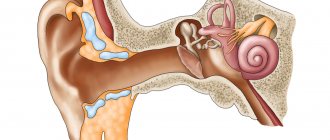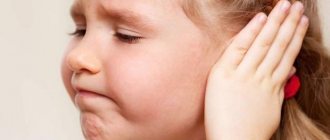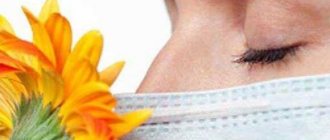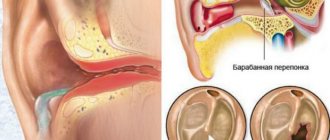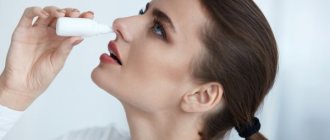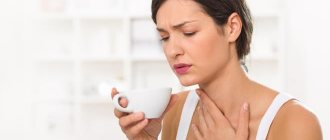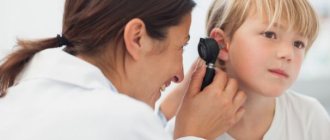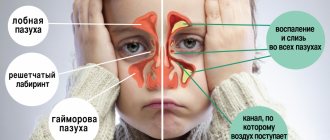Etiology
An allergic reaction provokes severe tissue swelling, as a result of which the diameter of the auditory tube is greatly reduced. This leads to disruption of its drainage function, which leads to the accumulation of effusion (exudate) in the tympanic cavity. The impetus for the development of pathological processes in the middle ear can be infectious diseases of the pharynx, nose and paranasal sinuses, which arise as a result of the development of acute respiratory viral infections, tonsillitis, rhinitis, sinusitis, etc.
Unlike other forms of ENT diseases, eosinophilic otitis is not provoked by bacteria, therefore, in the initial stages of treatment of the disease, taking antibiotics will not give any results. According to practical observations of doctors, the risk of developing the disease increases with:
- abnormal structure of the skull;
- decreased immunity;
- chronic infections;
- tendency to allergic reactions;
- diathesis and smoking.
Diagnosing the disease is very difficult due to the weak severity of the symptomatic picture. With prolonged course of otitis, hearing may deteriorate and autophony may develop.
Causes and risk groups
Allergic otitis in adults and children develops for a number of reasons. First of all, the risk group includes:
- patients suffering from Down syndrome;
- allergy sufferers;
- people with unfavorable heredity (meaning the presence of relatives suffering from a similar pathology);
- active or passive smokers.
Otitis caused by allergies leads to changes in the mucous tissues of the eardrums. As a result, there is a significant decrease in local immunity, due to which the body cannot fight infection that penetrates from the outside. This explains the specific clinical picture that this pathological process provokes.
In most cases, the causes of the development of the disease are previous infectious pathologies or the entry into the body of various contact allergens:
- microparticles of household chemicals;
- medications that are not intended to be administered into the ear.
Other factors that can provoke the occurrence of such a deviation may be:
- uncontrolled use of antibacterial drugs;
- fungal diseases of the ears;
- neglect of hygiene rules;
- negative changes in immune status.
Most often, the diagnosis of “allergic otitis” is made to patients suffering from bronchial asthma, urticaria, etc.
Clinical manifestations
Diagnosing allergic otitis media in adults is problematic, since the clinical manifestations of the pathology are mild. With this form of ear disease, the body temperature practically does not rise, and there is no pain in the ears. Otolaryngologists include among the most striking signs of the disease:
- slight hearing loss;
- discomfort inside the ear;
- feeling of fullness in the ears;
- mucous discharge from the ear canal;
- moderate to severe itching in the ear.
With the development of pathology, exudate accumulates in the tympanic cavity, which is the optimal environment for the development of microbial agents. As a result, a bacterial infection may occur in the middle ear, as evidenced by the following symptoms:
- elevated temperature;
- malaise and dizziness;
- discomfort and “shooting” in the ears;
- purulent discharge from the ear canals.
Important! Otitis complicated by infection can cause the development of more serious diseases, such as purulent labyrinthitis, encephalitis, facial nerve paresis, dysfunction of the auditory ossicles, etc.
Course and symptoms
The clinical picture of otitis caused by allergens is similar to catarrhal tubootitis. Swelling of the Eustachian tube leads to such a closure of its walls that the tube ceases to perform its function of ventilation and drainage of the tympanic cavity. Allergic symptoms of otitis media at this stage include:
- Ear congestion
- Hearing loss
- Noise in the ear
- Grinding sounds in the ear when swallowing and blowing your nose
symptoms of otitis media with an allergic dominant are similar to exudative otitis media. Long-term swelling of the Eustachian tube (for example, for a month) leads to swelling of the mucous membrane of the tympanic cavity. At the same time, due to a decrease in pressure in the middle ear, the eardrum becomes distorted, and the process of exudation of fluid from the blood vessels begins in the cavity. This stage is characterized by:
- Progressive hearing loss, the quality of which begins to depend on the position of the head.
- Sound distortion
- Sensation of fluid in the ear
We recommend reading: Dishes: pictures for children, kindergarten
At its extreme, the disease progresses to the stage of formation of fibrous bands, which can potentially impair hearing up to complete deafness.
One of the negative consequences of allergic dysfunction of the auditory tube may be the acquisition of a chronic form of tubo-otitis with the risk of exudation and transition of the disease to the adhesive stage, accompanied by complete immobility of the auditory transmitting system of the middle ear.
There is literally no special treatment for allergic otitis media. In this context, it is customary to talk about reducing the symptoms of irritation from exposure to an allergen. The following steps are advisable:
- Eliminating the allergen. This is easy if you are allergic to a food product, but difficult if, for example, you are allergic to plant pollen.
- Antihistamines form the basis of drug support. These are drugs such as:
- Diazolin
- Tavegil
- Diphenhydramine
- Suprastin and many others
If the allergy is life-threatening, it is advisable to use a course of immunotherapy, during which vaccination is carried out with antigens that cause
allergic reaction. A complete cure is difficult to achieve, but it is quite possible to reduce the symptoms.
Causes and risk factors
This disease does not appear on its own. Initially, it develops due to contact of the mucous membrane with an allergen.
This allergen may be:
- dust ;
- a parasite that lives on the skin of a pet;
- household chemicals;
- plant pollen;
- cosmetics;
- medicinal product.
In addition, an allergic reaction in the ear may occur in a person who:
- has relatives who suffer from allergies. Doctors note that allergies can be inherited from one relative to another. Therefore, all family members with allergies need to closely monitor their health;
- suffers from adenoiditis. This disease provokes the appearance of congestion in the eardrum, creating favorable conditions for the development and spread of pathogenic bacteria throughout the body;
- suffers from bronchial asthma. If a person is in almost constant contact with allergens, then ordinary otitis media can quickly turn into an allergic form;
- suffers from chronic rhinitis. Very often, allergies in the nasopharynx and larynx lead to allergic otitis media. And such a phenomenon is very dangerous;
- smokes cigarettes or is a passive smoker. Nicotine and tobacco smoke often lead to inflammation of the mucous membrane of the ear canal and the development of dangerous ailments.
Otitis media also provokes:
- infection that has entered the ear canal or intestines from other ENT organs;
- a person living in an area with poor environmental conditions;
- long-term use of antibiotics by the patient;
- work in difficult working conditions. Allergic otitis often appears in people who work in enterprises with strong vibration and interact with toxic substances;
- fungus located in the ear canals;
- reduced immunity;
- frequent trauma to the skull. Therefore, very often allergic otitis media is diagnosed in young children and athletes involved in dangerous sports.
Characteristic symptoms
The presence of pathology in a baby can be judged by certain signs. The child becomes inattentive, develops worse than his peers, always talks loudly, gets irritated when reprimanded, and the student begins to study poorly.
In children, the appearance of otitis is indicated by restless sleep, lack of appetite, frequent crying, and exudate.
In adults at the first stage of otitis development:
- Stuff and noise in the ears.
- Hearing gets worse.
- There is a feeling of fullness.
If a person does not pay attention to these symptoms, sounds are distorted, there is a feeling that fluid is overflowing in the ear, and severe pain occurs. With exudative otitis media, mucus begins to secrete from the ear canal and microbes begin to multiply. A person’s temperature rises sharply, his ears “shoot”, and pus accumulates.
It was previously noted that this disease is difficult to diagnose due to nonspecific symptoms. In other words, the complaints that patients present with may also apply to other diseases.
Symptoms of allergic otitis media include:
- itching;
- mucous discharge;
- ear congestion;
- sensation of noise or fluid transfusion inside the ear;
- decreased hearing level.
If the patient’s complaints also include pain that is shooting in nature, then this indicates a secondary inflammatory reaction, when an infection is added to the disease.
The clinical picture of otitis caused by allergens is similar to catarrhal tubootitis. Swelling of the Eustachian tube leads to such a closure of its walls that the tube ceases to perform its function of ventilation and drainage of the tympanic cavity. Allergic symptoms of otitis media at this stage include:
- Ear congestion
- Hearing loss
- Noise in the ear
- Grinding sounds in the ear when swallowing and blowing your nose
Further symptoms of otitis with an allergic dominant are similar to exudative otitis. Long-term swelling of the Eustachian tube (for example, for a month) leads to swelling of the mucous membrane of the tympanic cavity. At the same time, due to a decrease in pressure in the middle ear, the eardrum becomes distorted, and the process of exudation of fluid from the blood vessels begins in the cavity. This stage is characterized by:
- Progressive hearing loss, the quality of which begins to depend on the position of the head.
- Sound distortion
- Sensation of fluid in the ear
At its extreme, the disease progresses to the stage of formation of fibrous bands, which can potentially impair hearing up to complete deafness.
Allergic diseases can have a wide variety of symptoms. Problems usually arise from the skin, eyes and respiratory system.
However, in some cases, the pathology affects the ear area.
In such cases, doctors diagnose allergic otitis media, which is also called secretory otitis media.
This pathology is allergic in nature and provokes inflammation in the outer or middle ear. The cause of the disease can be bacterial microorganisms or food products.
This type of otitis can be external or middle. In the first case, the reason may lie in the use of jewelry or a hearing aid. Also, the use of ear drops often leads to external otitis.
Pathology may appear against the background of asthma or rhinitis. Sometimes this type of otitis is the result of exposure to food allergens.
However, antibacterial medications are not effective in treatment. Only antihistamines help eliminate the pathology.
Most often, the allergic form of otitis develops in children, especially after viral infections. In such a situation, an increase in temperature may occur. If a person has had cases of allergic otitis media in the past, relapses may occur after each infection.
The following factors may be prerequisites for the appearance of otitis media:
- weakening of protective forces;
- the person has allergies;
- damage to the eardrum;
- hypothermia.
Symptoms
The pathology has a sluggish course and does not provoke acute symptoms. When allergic otitis occurs, a person experiences discomfort in the ear, which is accompanied by swelling of the auditory canal. However, there is no intense pain.
In adults
Allergic otitis media usually has the following clinical picture:
- congestion in the ears;
- general weakness;
- slight increase in temperature;
- hyperemia of the skin in the ear area;
- high fatigue.
Pathology often provokes purulent discharge from the ears. This symptom indicates a ruptured eardrum. After the exudate is removed, the patient's condition improves significantly. In this case, the body temperature immediately normalizes.
In children, this type of otitis develops quite quickly, but does not always have an intense course. The pathology is characterized by the following signs:
- pain in the ear area;
- high irritability;
- purulent discharge from the ears;
- insomnia;
- hearing loss.
Often allergic otitis media in children is accompanied by the same type of rhinitis. In addition, inflammatory damage to the ear can be caused by sinusitis or adenoid growths. If these disorders are not dealt with in time, there is a risk of relapse of otitis media.
It is quite difficult to identify this form of otitis in an infant.
Usually this disease is accompanied by constant crying, loss of appetite, drowsiness or anxiety.
The baby may cry when feeding, because at this moment there is pressure in the nasopharynx, causing severe pain.
In schoolchildren, this form of otitis may be noticed by a teacher, since the disease provokes the following symptoms:
- inattention in class;
- slow reaction;
- decline in academic performance;
- tendency to talk loudly.
Treatment
The main method of treating this type of otitis is to detect the allergen and eliminate its effect on the body. It is also very important to select symptomatic therapy that will normalize the person’s condition.
Treatment includes the following components:
- Elimination of major allergens. If otitis media is the result of a food allergy, the person will need to follow a special diet.
- Taking antihistamines. The doctor can prescribe suprastin, diazolin, tavegil.
- The use of glucocorticosteroid hormones. To eliminate the symptoms of the pathology, local application of hormonal ointments or hydrocortisone infusions may be prescribed.
- Vasoconstrictor drops in the ear. These medications help maintain the patency of the auditory tube.
- Ear rinsing. For this purpose, a solution of hydrogen peroxide or boric acid with a concentration of 3% can be used.
- Use of immunomodulatory agents.
- Following a special diet.
If allergic otitis media becomes chronic, surgery may be necessary. If surgery is not performed in a timely manner, there is a risk of developing dangerous complications. These include facial paralysis, the development of cholesteatoma or atrophy of the eardrum.
Oddly enough, but allergic otitis media in a child or an adult is a manifestation of a banal allergy. A similar diagnosis can occur not only among children, but also among the adult population.
The mechanism of development of the disease in people of different age groups is the same: swelling of the nasal mucous membranes, caused by the introduction of an irritant, spreads to the area of the Eustachian tube, which causes its inflammation.
Allergic otitis media
According to statistics, the disease has a seasonal pattern: in spring and summer, due to the active flowering of plants, the incidence increases. Allergic otitis media more often affects residents of megacities or industrial cities with a poor ecological environment, and it is more difficult to treat under these conditions.
The causes of allergic otitis media in young children are often artificial formulas that replace natural feeding.
The environment where the child is located plays a big role in the growing body.
You need to take special care of the cleanliness of the air, because it is in the air space that a huge amount of dust, pathogenic flora, microparticles and foreign inclusions accumulate.
Allergic otitis may occur after exposure to an irritant that causes a pathological reaction in the body. An allergen in both adults and children can be:
- household dust, old furniture and mattresses, wall mold;
- smell, plant pollen;
- some food products, especially unusual for the area where a sick person lives: citrus fruits, juices from exotic fruits, dates, candied fruits, wild strawberries, strawberries, peaches, aromatic grape varieties. Honey and all bee products can cause symptoms of allergic otitis media in children and adults;
- chemical compounds: household chemicals, cosmetics or medications, including some types of ear drops;
- pets, especially “overseas” animals and birds;
- hearing aids, especially the first generations of devices;
- weather conditions: cold or heat, high humidity, sharp fluctuations in air temperature.
Diagnosis of this particular form of otitis can be difficult.
To accurately verify the diagnosis, the ENT doctor collects an anamnesis of the patient’s life and illness, makes a detailed analysis of the complaints, and finds out the presence of allergies among blood relatives.
It is useful to order a series of laboratory tests, conduct an instrumental examination of the middle ear, and, if necessary, request the consultation of “narrow” specialists (allergist, neurologist, etc.).
Only after a thorough diagnosis is therapy prescribed that is adequate to the severity of the patient’s condition. Errors in the treatment regimen are fraught with insufficient, unstable therapeutic effect and the occurrence of complications, including:
- transition of the disease from an acute to a chronic form (chronization of the process of inflammation of the middle ear);
- persistent, almost irreversible hearing loss, up to complete deafness;
- cholesteatoma;
- paralysis of facial muscles;
- atrophic or necrotic changes in the eardrum, etc.
Symptoms
Symptoms of allergic otitis media
The presence of pathology in a baby can be judged by certain signs. The child becomes inattentive, develops worse than his peers, always talks loudly, gets irritated when reprimanded, and the student begins to study poorly.
In children, the appearance of otitis is indicated by restless sleep, lack of appetite, frequent crying, and exudate.
In adults at the first stage of otitis development:
- Stuff and noise in the ears.
- Hearing gets worse.
- There is a feeling of fullness.
If a person does not pay attention to these symptoms, sounds are distorted, there is a feeling that fluid is overflowing in the ear, and severe pain occurs. With exudative otitis media, mucus begins to secrete from the ear canal and microbes begin to multiply. A person’s temperature rises sharply, his ears “shoot”, and pus accumulates.
In an adult
The pathological process in the ear is preceded by infection with bacteria and the penetration of chemical particles into the body in everyday life or at work. Promote the appearance of otitis media of an allergic nature in adults:
- fungal infections of the mucous membrane;
- decrease in protective forces;
- long-term use of antibiotics;
- cigarette smoke;
- poor hygiene.
Smokers and asthma patients have inflamed ears more often than other patients. The risk group includes people whose immediate family suffers from allergies.
In children
At first, allergic otitis is asymptomatic, then, under the influence of the irritant, severe itching and burning in the ear appears. If you feel shooting pain, there is an infection in the ear canal.
Sluggish symptoms cause difficulties with diagnosis and delay the start of effective treatment.
Signs of otitis media in a child:
- congestion, tinnitus;
- hearing loss;
- poor sleep;
- lack of appetite;
- feeling of fullness in the ear;
- discharge of fluid from the ear canal;
- shootings in the ear;
- heat;
- the appearance of pus in the ear.
If a child has an inflamed middle ear under the influence of an allergen, he becomes nervous and irritable, inattentive to others. Adults notice that the little patient has problems with hearing, since he does not answer questions immediately.
The child begins to talk louder, lags behind his peers in development, and studies worse.
You need to see a doctor in a timely manner.
Allergic otitis media treatment
Allergic otitis media is not an independent disease. It always occurs as a continuation of allergic rhinitis or runny nose.
An allergic reaction is an erroneous response of the immune system to foreign proteins (allergens). Since the most rapid contact occurs when allergens come into contact with mucous membranes, the most common symptom of allergy is swelling of the nasal mucosa, i.e. runny nose.
The nose, throat and ear are naturally united into one organ system: they communicate and have mucous membranes. The ear consists of three segments. Allergic edema affects one of them - the so-called middle section, which includes the tympanic cavity and the Eustachian tube, which connects the cavity to the nasopharynx.
The following may act as an allergen:
- plant pollen,
- Food,
- ordinary dust
- other reasons (for example, bright sunlight or cold air).
Once in the body, allergens cause irritation of the mucous membranes of the nose and throat. In some cases, swelling may affect the mucous membrane of the Eustachian tube, which gives rise to talk about
Therefore, the basis for the prevention of allergic otitis is a correct lifestyle, starting from childhood. It includes:
Acute purulent otitis media
It is also an acute infectious disease, but in which all three parts of the middle ear are involved in the pathological process. A distinctive feature of acute purulent otitis is the formation and accumulation of a large amount of purulent contents in the tympanic cavity, and the development of complications. The infection enters the middle ear most often through the auditory tube.
Numerous observations have shown that microorganisms such as H. Influenzae, S. Pneumoniae, and less commonly M. Cataralis and S. Aureus are involved in the development of this type of inflammation. An important predisposing factor is a general decrease in the body's defenses, trauma, wounds in the middle ear, including an overly active inflammatory response to the introduction of pathological bacteria. Clinical symptoms are somewhat different from the previous two forms of middle ear disease. There is already a staged nature of the pathological process.
Each stage is characterized by its own characteristics, but in general it is the same pathological process, conditionally divided for the convenience of recognizing the degree of pathological damage, correct assessment of the current situation and selection of the appropriate treatment method. The name and symptoms of each are as follows:
- Pre-perforative - means the initial pathological process in which there is no destruction of the eardrum.
The main complaint of patients is severe pain, which moves to the temple and crown area.
We recommend reading: A child has a stomach ache and vomiting: reasons, what to do
The pain is characterized by pulsation, with periods of intensification and lull. The occurrence of this symptom is due to the fact that the mucous membrane of the middle ear becomes inflamed, and the accumulated fluid increases the pressure inside the tympanic cavity and has an irritating effect on pain receptors. In parallel, other symptoms are present, as with tubo-otitis. The symptom of increasing hearing loss is especially evident. General symptoms of intoxication are manifested by increased body temperature, which usually does not exceed 38 degrees Celsius. Other common symptoms are diffuse headache, deterioration in general health, weakness, dizziness and even vomiting.
During otoscopy (examination of the external auditory canal and eardrum), protrusion of the eardrum and its pronounced redness are detected. The first stage of the infectious-inflammatory process with purulent otitis media lasts from 3-4 hours to several days.
- Perforated. The inflammatory process at the local level is characterized by the formation of mucus, and subsequently pus, which has pronounced proteolytic properties, that is, it can dissolve the surrounding tissue. This is what happens in the perforated stage of purulent otitis media. The walls of the eardrum gradually become thinner and, if the active inflammatory process is not reduced, eventually a small hole forms in it, through which purulent masses begin to leak.
When the eardrum is perforated (ruptured), the pressure in the tympanic cavity sharply decreases, and acute unbearable pain subsides sharply. Symptoms of intoxication also decrease, the temperature drops to more physiologically normal numbers (low-grade fever 37-37.5 degrees). The size of the hole in the eardrum with purulent otitis media depends on the type of pathological agents, that is, simply put, pathogens. The duration of suppuration usually lasts for a week, after which the inflammatory process subsides and the disease enters its final stage.
- Reparative . This stage means that the disease is in the recovery stage, during which inflammatory processes gradually subside and healing of the affected tissue begins. Purulent discharge disappears, the general condition becomes much better, the body temperature returns to normal.
With a long, protracted inflammatory process, auditory functions are significantly impaired. The disease can be complicated by the spread of infection to neighboring areas, which will significantly worsen the situation and create a risk to the patient’s life. After healing, depending on the degree of destruction, scars of different sizes form in the eardrum, and the function of conducting sound waves by the auditory ossicles is also impaired. Timely diagnosis and timely initiation of rational treatment will greatly alleviate the patient’s suffering and also speed up the recovery process. Under normal general conditions, the disease lasts about 15-20 days.
Eustachitis (tubootitis)
The most common causes of dysfunction of the auditory tube are chronic diseases of the nasal cavity and sinuses, as well as adenoiditis and deviated nasal septum. Prolonged compression of the ear canal interferes with the penetration of air into the tympanic cavity. The consequence is rarefaction of air and a decrease in pressure inside the middle ear cavity. In this case, the eardrum is pulled inward, hearing is partially impaired, and congestion occurs, in which fluid accumulates. Over time, pathogenic bacteria can join and cause an inflammatory and infectious process.
The initial complaints of a patient suffering from eustachitis are: a feeling of fullness in the ear, decreased perception of sound. The patient seems to hear his own voice in his ears. This phenomenon is called autophony. But, despite the presence of these symptoms, we can say with confidence that there is inflammation of the auditory tube. For example, a sudden change in atmospheric pressure, when flying on an airplane or swimming underwater, can cause a blocked ear.
Fever, pain and other phenomena that accompany any acute inflammatory process are not typical for tubo-otitis. When the cause that caused the closure of its lumen is eliminated, all of the above symptoms disappear. But a long-term blocked passage of the auditory tube, combined with decreased immunity and the addition of a bacterial or viral infection, can lead to complications in the form of various forms of acute and chronic otitis media.
Mastoiditis
This is an acute purulent disease of the mastoid process, in which both the mucous membrane and the bone base can be involved in the pathological process. The disease is caused by the spread of the inflammatory process from the tympanic cavity. The microorganisms are the same as in other inflammatory processes of the upper respiratory tract.
Clinical symptoms of the disease depend on the stage of the pathological process. In the initial stages, when only the mucous membrane of the mastoid cells becomes inflamed, the symptoms are practically no different from those of acute purulent otitis. There are general symptoms of intoxication, with fever, headache, dizziness and nausea.
With further development of the pathological process, inflammation spreads to the mastoid bone. The general condition is much worse. A large amount of pus accumulates inside the tympanic cavity and in the mastoid cells, which significantly increases the pressure inside them. If drainage is not performed, purulent masses can break through: through the eardrum, through the meninges, causing severe complications in the form of inflammatory brain pathologies. There are also possible ways for pus to penetrate into the cervical region.
Local symptoms at this stage of the disease are:
- Feeling of pressure in the ear.
- Unbearable pain in the head and parotid space.
- Upon examination, you can clearly notice the ear anteriorly, and protrusion and severe redness with a cyanotic tint behind the ears. If you press on this area, a sharp pain will appear.
- A sharp drop in body temperature and relief of the patient’s general condition, combined with suppuration from the ear, will indicate that there is a breakthrough in the eardrum.
- Hearing deteriorates significantly.
Stages of the disease
There are the following stages of ear allergies in adults, which are accompanied by the appearance of certain symptoms:
- Crust stage. This stage of the disease is characterized by drying of the resulting secretion and the formation of yellow crusts. If timely effective therapy is not carried out, the person’s condition worsens significantly, the epidermis is destroyed, the auricle itches and the likelihood of infection spreading is high.
- Wet stage. This stage is characterized as a period of exacerbation and the opening of previously formed blisters occurs. A pathogenic fluid is released from them, which causes severe irritation and wetness of the skin behind the ears.
- The appearance of rashes. Blisters appear on the patient's skin, inside of which fluid accumulates. With this pathological condition, the ears are very itchy, but this should not be done.
- Erythematous condition. This stage of the disease is characterized by slight redness of the skin and its thickening.
It is important to diagnose ear dermatitis as early as possible and begin treatment. This is due to the fact that ear allergies can become chronic. In this case, characteristic symptoms occur in the patient with some frequency, and relapses are replaced by short remissions.
Dermatitis in the ear area in an adult
Diagnostics
Remember: only a doctor treats allergic otitis media. Only he can make an accurate diagnosis.
Initially, the doctor performs a paracentesis of the membrane. In this procedure, he pierces the eardrum with a special needle. With allergic otitis in a child, a mucous viscous fluid will be released from the ear. It is by this that the doctor determines the disease.
If mucopurulent fluid is released from the ear, this indicates the development of a bacterial infection in the ear canal.
Additionally, the patient will have to donate blood for analysis. It determines the amount of immunoglobulin E and eosinophils.
Remember: if the diagnosis is made incorrectly, then the treatment of ear allergies will be carried out incorrectly, and it will take a very long time to treat the disease.
Treatment of allergic otitis media
Complex therapy for adults and children begins with identifying the allergen, studying complaints (history) and examining the patient. If the irritant is a food product, a therapeutic diet is needed. If you are allergic to animal hair or household dust, contact with them should be stopped.
For successful treatment, it is necessary to identify concomitant diseases.
For a bacterial infection, systemic antibiotics (Erythromycin, Amoxicillin) are needed for a course of 5–7 days. For viruses and fungi, such medications are powerless.
Immunotherapy
To determine the irritant, the doctor performs an allergy test. To stop an attack and speed up recovery, allergen-specific immunotherapy (ASIT) is prescribed in the hospital. The allergen is introduced into the body over a long period of time so that the immune system gradually gets used to its presence and perceives it calmly. Over time, the symptoms of otitis media weaken: itching and swelling disappear, and pus no longer comes out of the ear.
First, the allergen is introduced in a relatively low concentration. Gradually its level increases to the maximum permissible limit. At the second stage, the optimal dose enters the body over a long period of time and is determined individually based on a number of indicators (strength of the allergen, method of administration, reaction in the child and adult).
Rinsing the ear cavity
Before pouring medicinal solutions into the Eustachian tube, it is important to make sure that the pus has not ruptured the eardrum. This requires a diagnosis from an otolaryngologist. Effective solutions for rinsing the ear - Furacilin, hydrogen peroxide, potassium permanganate. The medicine is administered with a syringe without a needle. Ear rinsing is necessary to remove pus from the ear canal.
General recommendations from doctors:
- Heat the healing solution only in a water bath.
- Use a sterile syringe to rinse the ear.
- After the procedure, avoid drafts for several hours.
- Do not stop drug therapy.
- Avoid damaging the ear canal, otherwise infectious agents may enter the ear.
Allergic otitis in children and adults: methods of conservative and alternative treatment
At any age, treatment of an inflammatory process in the ear of immunological etiology should begin with eliminating its cause. In other words, you need to minimize, and ideally completely eliminate, contact with the allergen. True, doctors note that few people manage to do this.
Then the main efforts should be aimed at eliminating swelling of the mucous membrane of the nasal cavity and nasopharynx.
For this purpose, several groups of drugs are used:
- Vasoconstrictor local agents . They are contraindicated for use for more than 5-7 days. They do not act in any way on the main cause of allergic otitis in adults and children, but their use allows you to quickly remove the main clinical signs of the disease.
- Intranasal corticosteroids . They are one of the most effective remedies for the treatment of allergic rhinitis, but their effect develops over 7-10 days, so they are recommended as a preventive measure for exacerbations of ear inflammation.
- Antihistamines , both for systemic and local use. These drugs quickly relieve swelling, the main etiological factor of otitis media. Due to their safety and high therapeutic effect, they are one of the most common drugs; they are prescribed not only for allergic otitis and rhinitis, but also for respiratory lesions as a result of ARVI.
- Drops in the ear , almost all drugs in this group contain several components that eliminate not only the inflammatory process, but also pain. But doctors emphasize that almost all of them are contraindicated in case of perforation of the eardrum and discharge of mucous or purulent secretion from the ear canal.
Allergic otitis media in children and adults requires antibiotic therapy only in case of infectious complications; their first clinical manifestation is an increase in body temperature.
They are taken as prescribed by a doctor only after confirmation of the diagnosis. Self-medication is unacceptable; at best it will not bring results, at worst it will cause numerous unwanted reactions.
Allergic otitis media in children is treated with the following medications:
- To eliminate edema and rhinorrhea, drops of Vibrocil, Otrivin 0.05% are suitable. If the child is unable to blow his nose on his own, the nasal cavity is cleaned using an aspirator.
- Nasal corticosteroids are used only from two years of age. Despite the fact that their low systemic bioavailability is confirmed by the results of clinical trials, they are prescribed for strict medical indications. At an early age, this is a combination of allergic rhinitis and adenoiditis and associated recurrent otitis. Avamys is usually prescribed 1 spray once a day.
- Not all antihistamines can be taken at an early age. Fenistil drops for internal use are considered relatively safe. They can even be used on infants. The exact dosage depends on the weight and age of the child. In addition, a gel of the same name is produced, which can be applied to the auricle for external allergic otitis in children.
- Otipax ear drops contain the analgesic lidocaine and the anti-inflammatory phenazone. However, they should be used only if the eardrum is intact, 1-2 drops in each ear canal 2-3 times a day. The medicine is prescribed to children from birth.
- If bacterial complications occur, penicillin antibiotics (Flemoxin Solutab, Augmentin) are usually prescribed; the exact dosage must be calculated by the pediatrician.
You can try to cure allergic otitis in children with folk remedies. A very common method of therapy is drops of boric alcohol, herbal candles, which you can prepare yourself from wax paper or purchase at a pharmacy (photos of them are available on the websites of stores specializing in herbal medicine). Walnut oil also has a good effect when used topically. Warming up with a blue lamp has not lost its significance, which, by the way, has recently reappeared on pharmacy shelves.
The basic principles of how to treat allergic otitis media in adults are no different. However, the range of drugs used is significantly expanding. Any spray is suitable as a vasoconstrictor. However, preparations with various herbal components, especially eucalyptus and mint, should be avoided. Therefore, it is recommended to stick to long-acting Nazivin, Xylometazoline, etc.
Antihistamines for adults are usually prescribed only in tablet form, since sprays may not be effective enough and may not affect the inflammatory process in the nasopharynx. Doctors prefer to prescribe medications with minimal risk of adverse reactions, for example, Erius, Claritin, Suprastinex, 1 tablet once a day.
Nasal corticoids are also more common than in childhood. The only contraindications are hypersensitivity, pregnancy and lactation. They use the same Avamis, Flix, Momat Rhino Advance. But the dosage is 2 sprays up to 2 times a day. For ear drops, we can recommend Otinum or Otizol. Perforation of the eardrum is also a contraindication to their use.
Traditional healers believe that allergic otitis media in adults can be cured using cotton wool pads generously soaked in onion juice. They should be inserted into each ear canal at night. It is also recommended to use candles made from laundry soap instead, and apply a compress of camphor oil on top.
Allergic otitis in adults and children requires a serious approach to the composition of the diet. A child, for example, may be hypersensitive to cow's milk protein, chocolate and other foods. They should definitely be replaced with ones that are equivalent in calorie content and the presence of useful vitamins and microelements, but are hypoallergenic. In addition, medical institutions recommend taking a course of specific immunoprophylaxis. Currently, this method of treatment is quite common and allows you to almost completely get rid of the symptoms of the pathology.
Otitis in adults
Reducing pain: For pain relief at the initial stage of otitis, Paracetamol is prescribed (1 g 4 times a day for adults, for children doses are selected depending on body weight). Otipax ear drops (composition: lidocaine hydrochloride, phenazone, sodium thiosulfate, ethyl alcohol and glycerin) have an analgesic effect. Otipax is instilled into the external auditory canal, 4 drops 2-3 times a day. To reduce pain, a Tsitovich compress is used (a gauze swab is soaked in a 3% alcohol solution of boric acid and glycerin and inserted into the external auditory canal). This compress can be left in the ear for 3-5 hours.
In order to reduce swelling of the auditory tube and improve the outflow of pus from the middle ear, nasal drops are prescribed: Naphthyzin, Santorin, Tizin, Nazivin. Nazivin is prescribed to children 1-2 drops in each nostril 2-3 times a day.
Antihistamines sometimes help reduce swelling of the mucous membrane of the auditory tube: Diphenhydramine, Suprastin, Tavegil, Claritin, Telfast. The prescription of antihistamines is recommended only in cases where otitis media develops against the background of allergies. Suprastin is prescribed to children at 8.3 -12.5 mg 2-3 times a day.
Antibiotics to suppress middle ear infections. The basis of treatment for acute suppurative otitis media is antibiotic therapy.
According to the latest data, the most effective drug in the treatment of acute otitis in children and adults is Amoxicillin (0.25–0.5 g orally three times a day for 10 days). Sometimes a situation arises in which treatment with Amoxicillin does not lead to an improvement in the patient's condition. If there is no effect after three days of treatment with Amoxicillin, the drug should be changed to Augmentin (0.375 or 0.625 g orally two to three times a day) or Cefuroxime (0.25 or 0.5 g orally twice a day).
If the above-mentioned antibacterial agents are intolerant or ineffective, macrolide antibiotics are prescribed (Rulid 0.15 orally twice a day; Spiramycin 1.5 million IU orally twice a day).
For complicated forms of otitis, drugs are prescribed such as: Sparflo 400 mg orally on the first day, then 200 mg per day; Avelox 400 mg orally once a day.
The duration of treatment for otitis should be at least 8-10 days. Even if the patient's condition improves, treatment with antibiotics should be continued. Early discontinuation of antibiotics can lead to relapse (recurrence) of the disease and the development of hearing loss.
Local treatment for otitis. Compresses, hygiene
For otitis, use a warm compress on the ear (a nodule with heated salt), which accelerates the resolution of the inflammatory process. If, after applying a compress, the patient notices increased pain in the ear, the compress should be removed immediately.
It is necessary to independently remove purulent secretions from the ear canal several times a day. For these purposes, you can use cotton swabs.
When cleaning the ear, pull the pinna backwards and upwards (for a child - backwards and downwards) and a cotton swab is carefully inserted into the ear canal. The procedure is repeated until the cotton wool remains dry and clean. In case of thick pus, a warm solution of 3% hydrogen peroxide is first poured into the ear canal, after which the ear should be thoroughly dried with a cotton swab. After removing the purulent secretion, a 0.5–1% Dioxidine solution heated to 37°C or Tsipromed ear drops is injected into the ear. For sluggish otitis, you can use tinctures of iodine and lapis (40%).
Surgical treatment of otitis.
When the patient’s condition does not improve with drug treatment, then surgical methods are used to treat otitis media in children. The most widely used is tympanic cavity bypass. If, despite the treatment, the patient’s condition does not improve, he is still bothered by severe pain in the ear, a high temperature persists, pain is detected when pressing on the mastoid process, and a protrusion of the eardrum is observed during otoscopy, then paracentesis is performed - an incision of the eardrum.
Drug therapy
Medications are designed to stop the pathological effects of the allergen on the body and neutralize the hyperergic reaction of the immune system to it. Drug therapy is selected by an otolaryngologist and an allergist. This depends on the course of the disease, the nature of the allergens and the severity of the symptoms of the disease. Antihistamines for otitis media play an important role in the treatment of the patient. They block inflammatory mediators in mast cells and reduce symptoms.
The following drugs are used:
- Telfast;
- Zyrtec;
- Cetrin;
- Suprastin;
- Pipolfen;
- Tavegil;
- Fenkarol;
- Claritin;
- Zodak;
- Semprex;
- Erius;
- Xizal;
- Desloratadine.
Other groups of drugs are used to treat allergic otitis media in adults. They are used to relieve symptoms of the disease. Drops are mainly used to treat allergic otitis media. They are instilled into the ears and nose.
The following groups of drugs are used:
- glucocorticoids (Betamethasone, Prednisolone ointment, Elokom) – reduce the manifestations of allergies, have an anti-edematous and anti-inflammatory effect, used in the form of ointments that are placed in the external auditory canal;
- antibiotics (Sofradex) are used when a bacterial infection is associated; drugs are selected taking into account the determination of the sensitivity of bacteria;
- vasoconstrictor drops (Frinozol, Otrivin, Rinonorm) reduce tissue swelling and are instilled into the nose and ears;
- antiallergic (Otinum, Anauran) drops are prescribed to eliminate itching and swelling.
Treatment of allergic otitis in children and adults using antibiotic therapy is carried out only in case of confirmed bacterial infection.
Drops for allergic otitis media
Allergy treatment is comprehensive and includes the following groups of medications:
- Vasoconstrictors. They do not treat the cause, but eliminate the symptoms of otitis: relieve swelling, relieve inflammation. Drops can be used for no longer than 5–7 days.
- Nasal corticosteroids (hormones). They are effective, but the therapeutic effect develops after 7–10 days. Such drops are often used to prevent exacerbations of otitis media.
- Antibacterial drops. They help if a pathogenic infection has entered the ear and complicated the course of otitis media. The course of treatment is 5–7 days, the choice of antibiotic is individual.
- Antiallergic drugs. Quickly eliminate swelling and itching, ease the course of an allergic reaction, and are more suitable for symptomatic treatment.
Frinozol
A colorless solution with an antiallergic effect reduces swelling and redness of the mucous membrane, restores the patency of the ear canal, and relieves allergy symptoms. The drug acts in 5–7 minutes, the effect lasts 4–6 hours. Frinozol is contraindicated in case of intolerance to the components, atrophic rhinitis, pregnancy, lactation, and children under 18 years of age. Side effects: allergies, apathy, convulsions. Analogues: Vibrocil.
Drops for allergic otitis media
Allergy treatment is comprehensive and includes the following groups of medications:
- Vasoconstrictors. They do not treat the cause, but eliminate the symptoms of otitis: relieve swelling, relieve inflammation. Drops can be used for no longer than 5–7 days.
- Nasal corticosteroids (hormones). They are effective, but the therapeutic effect develops after 7–10 days. Such drops are often used to prevent exacerbations of otitis media.
- Antibacterial drops. They help if a pathogenic infection has entered the ear and complicated the course of otitis media. The course of treatment is 5–7 days, the choice of antibiotic is individual.
- Antiallergic drugs. Quickly eliminate swelling and itching, ease the course of an allergic reaction, and are more suitable for symptomatic treatment.
Erius
Syrup and tablets relieve allergic reactions without affecting the nervous system or causing drowsiness. The therapeutic effect develops after 30 minutes and lasts throughout the day. Tablets are suitable for patients over 12 years of age, and syrup for babies over 6 months. Erius is contraindicated in cases of severe kidney damage and a tendency to allergies. Side effects: dizziness, tachycardia, drowsiness, urticaria, itching, skin rash. Analogues: Lordestin. Price 10 tablets – 580 rub.
In adults
At first, the disease does not manifest itself in any way. If exposure to the allergen does not stop, severe symptoms appear. Sleep and peace are disturbed, nervousness in behavior and aggression are present. Characteristic signs of allergic otitis in adults:
- Hearing impairment. Complaints of ear congestion, a feeling of the presence of water, and extraneous noises appear.
- Slight increase in body temperature. This is a sign that the inflammatory process is sluggish in the body.
- Itching in the ear. This is one of the main symptoms of otitis media of an allergic nature, which is accompanied by the discharge of pus from the ear canal.
- Earache. This symptom in adults indicates the presence of infection and the course of the inflammatory process.
- Genetic predisposition. The tendency to allergies in a person can be inherited.
- Adenoiditis. The disease can provoke congestion in the tympanic cavity, creating favorable conditions for the activity of pathogenic flora.
- Bronchial asthma. In this case, we are talking about an allergic form of the disease, which is associated with an identified irritant.
- Chronic rhinitis. Otitis becomes a complication of an allergic reaction in the nasopharynx and larynx.
- Active or passive smoking. Inflammation of the mucous membrane of the ear canal is caused by exposure to nicotine (tobacco smoke).
Clarification of the diagnosis of “internal otitis”: audiometry
A hearing test using a special device - audiometry, as well as measuring pressure inside the ear - tympanometry - is used to clarify the diagnosis if chronic otitis is suspected.
We recommend reading: Allohol for pancreatitis: can it be taken?
If hearing acuity during ongoing otitis media drops sharply and attacks of dizziness begin, there is a reasonable suspicion of internal otitis (inflammation of the ear labyrinth). In this case, audiometry is used, the help of an otolaryngologist and a neurological examination are used.
How is otitis externa treated?
If otitis externa is found in adults, the main treatment will be with ear drops. In a healthy person with normal immunity, otitis externa will go away using only drops; antibiotics in injections or tablets will not be needed. Drops can consist only of an antibacterial drug, or they can combine an antibiotic and an anti-inflammatory drug. Otitis externa is treated with drops for an average of a week.
Basically, for the treatment of external otitis the following is prescribed:
Antibiotics – norfloxacin (Normax), ciprofloxacin hydrochloride (Tsiprolet), rifamycin (Otofa);
Antibiotics with corticosteroids – Candibiotic (beclomethasone, lidocaine, clotrimazole, chloramphenicol), Sofradex (dexamethasone, framycetin, gramicidin);
Antifungal ointments - clotrimazole (Candide), natamycin (Pimafucin, Pimafucort) - are prescribed if otitis externa is of fungal origin.
Among the recently proven products, an ointment with the active ingredient “mupirocin” is used, which does not have a pathological effect on the normal microflora of the skin, but is active against fungi.
Folk remedies
It is possible to alleviate the patient’s condition using both traditional methods of treating ear dermatitis in humans and traditional medicine. In order for the effect to be more pronounced for ear allergies, it is recommended to carry out complex therapy. Folk remedies can be used for allergies in infants on the face, head and ears.
Traditional medicine offers the following recipes for the treatment of pathologies such as ear rashes:
- For seborrheic dermatitis in the ears, it is recommended to wash the affected areas of the skin with raw potato juice, which must be prepared immediately before use. It is recommended to carry out this procedure several times during the day, which allows you to dry the inflamed areas of the epidermis and prevent them from getting wet.
- It is possible to speed up the process of regeneration of damaged skin with the help of herbal decoctions, which have a pronounced antiseptic effect. You can brew chamomile, string or calendula and wash the inflamed areas of the skin with the solution. In addition, a water tincture of oak bark has a powerful effect.
- At home, you can prepare a tincture from walnut shells. To do this, you need to take an unripe walnut, carefully crush its shell and pour vodka. The resulting mixture should be infused for 5-7 days, then strain and add the same amount of propolis.
You can cure a rash behind the ear using lotions made from a decoction of onion peels, an infusion of dried nettle leaves and castor oil with the addition of egg yolk.
Diet
If a child or adult has allergy symptoms, nutritional adjustments are needed. It is important to exclude food allergens from your daily diet, which can aggravate otitis media. List of prohibited foods:
- citrus;
- cow's milk;
- sweets, sugar;
- baked goods;
- potato;
- eggs;
- red meat.
To make ear drops for allergic otitis work faster, it is important to include the following healthy foods in your daily menu:
- fresh fruits, vegetables;
- greenery;
- black currant;
- pumpkin;
- chicken bouillon;
- green tea.
Treatment
There is literally no special treatment for allergic otitis media. In this context, it is customary to talk about reducing the symptoms of irritation from exposure to an allergen. The following steps are advisable:
- Eliminating the allergen. This is easy if you are allergic to a food product, but difficult if, for example, you are allergic to plant pollen.
- Antihistamines form the basis of drug support. These are drugs such as:
- Diazolin
- Tavegil
- Diphenhydramine
- Suprastin and many others
If the allergy is life-threatening, it is advisable to use a course of immunotherapy, during which vaccination is carried out with antigens that cause an allergic reaction. A complete cure is difficult to achieve, but it is quite possible to reduce the symptoms.
Possible complications
Most often, complications with eczema of the outer ear result from the addition of a secondary bacterial infection due to inflammation of erosions and scratching. The consequence of this pathological process is the appearance of furunculosis and impetigo, which are accompanied by severe intoxication of the human body. Carrot juice also has wound-healing and regenerating properties, which can also be used to treat eczema on the skin.
In some cases, ear eczema can cause the development of erythroderma, lymphadenitis and lymphangitis. Damage to the ear canal may be accompanied by a narrowing of its lumen, and the formation of complete atresia if the disease lasts too long with constant relapses can transform into neurodermatitis.
Prognosis and criteria for recovery
If treatment is started on time, the prognosis is favorable. The criteria for recovery are the absence of exacerbations, the absence of eosinophils in the blood, and increased immunoglobulin E. Remission can be prolonged with timely treatment and the absence of contact with the allergen.
An unfavorable prognosis for a patient in the absence of treatment or untimely initiation of therapy. It is possible to develop hearing loss or complete hearing loss.
Allergic otitis media is an insidious disease whose symptoms do not appear immediately. It is dangerous due to the development of complications that are difficult to correct and treat. Therefore, if symptoms of otitis media appear, you should consult a doctor and start treatment in a timely manner.
Causes and symptoms
Allergic otitis is a sluggish inflammation of the middle ear, accompanied by swelling of the tissues of the auditory tube, tympanic cavity and accumulation of fluid (effusion) in the middle ear cavity. In this case, no signs of infection are observed. Very often, the pathology develops against the background of other allergic diseases.
Factors that contribute to the appearance of signs of the disease include:
- genetic predisposition;
- presence of Down syndrome;
- smoking, both active and passive;
- development of primary immunodeficiencies;
- craniofacial anomalies.
But most often the symptoms of allergic otitis appear in patients:
- vasomotor rhinitis;
- bronchial asthma;
- urticaria, etc.
In such cases, people notice mucous discharge, sometimes mixed with pus, and complain of a feeling of stuffiness in the ear. In certain cases, the picture is complemented by eczema of the external auditory canal and, accordingly, constant itching. But the sharp, shooting pains typical of otitis media can only occur as a result of an infection. However, many patients note that after suffering from any illness, including a common ARVI, there is an increase in discomfort and there may even be a sensation of fluid transfusion in the ear.
Due to the lethargy and low severity of symptoms, allergic otitis media is dangerous because in the absence of timely treatment, patients risk losing hearing acuity or acquiring autophony, that is, a special auditory defect consisting in increased perception of one’s own voice.
Prevention of pathology
In order to avoid the appearance of eczema on the ears, it is recommended to follow some prevention rules:
- make your diet balanced and rational, filling it with vitamin complexes;
- monitor your emotional background;
- observe the rules of hygiene for body care;
- use only high-quality cosmetics and follow the rules for their storage;
- spend a lot of time outdoors.
Recovery largely depends on the ability to eliminate etiological factors and correct various disorders that have arisen in the functioning of organs and systems. With timely diagnosis of the disease and initiation of effective treatment, it is possible to cope with the acute form within 20-25 days. If a child has a red, inflamed ear and it is very flaky, then it is necessary to show it to a doctor and not self-medicate.
